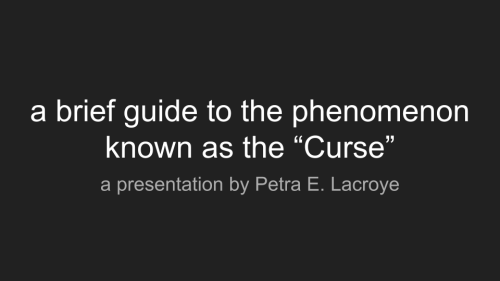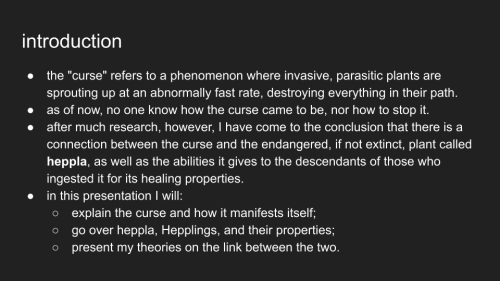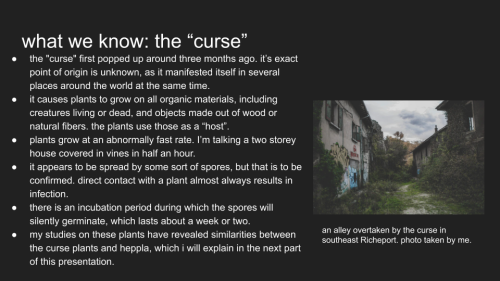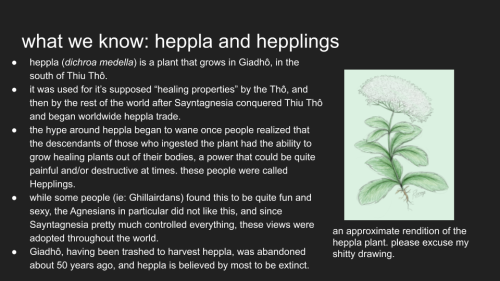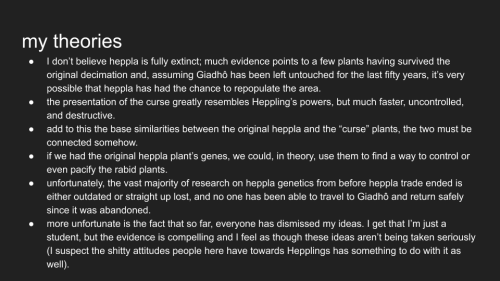wasteland worldbuilding ❃ petra’s guide to the curseokay so neither powerpoint nor TED
wasteland worldbuilding ❃ petra’s guide to the curseokay so neither powerpoint nor TED talks exist in the wastelandverse, but hypothetically these are the handouts Petra would have ready for the first meeting of the Road Trip Planning Committee.learn more about heppla here.transcription below.a brief guide to the phenomenon known as the “Curse”a presentation by Petra E. Lacroyea forewordwhat we’re dealing with is no mystical, magical “curse”. it is a scientific phenomenon like any other, just one that we do not understand yet. I am simply using that term in this presentation as it is the one most people are familiar with.as a lowly ecology student, I am not an expert in any of these fields; however, I have done extensive research, both for my undergrad thesis and for my own personal gratification, and can supply credible sources for all my information.introductionthe “curse” refers to a phenomenon where invasive, parasitic plants are sprouting up at an abnormally fast rate, destroying everything in their path.as of now, no one know how the curse came to be, nor how to stop it.after much research, however, I have come to the conclusion that there is a connection between the curse and the endangered, if not extinct, plant called heppla, as well as the abilities it gives to the descendants of those who ingested it for its healing properties.in this presentation I will:explain the curse and how it manifests itself;go over heppla, Hepplings, and their properties;present my theories on the link between the two.what we know: the “curse”the “curse” first popped up around three months ago. it’s exact point of origin is unknown, as it manifested itself in several places around the world at the same time.it causes plants to grow on all organic materials, including creatures living or dead, and objects made out of wood or natural fibers. the plants use those as a “host”.plants grow at an abnormally fast rate. I’m talking a two storey house covered in vines in half an hour.it appears to be spread by some sort of spores, but that is to be confirmed. direct contact with a plant almost always results in infection.there is an incubation period during which the spores will silently germinate, which lasts about a week or two.my studies on these plants have revealed similarities between the curse plants and heppla, which i will explain in the next part of this presentation.[image: an alley with crumbling buildings filled with vines, captioned: “an alley overtaken by the curse in southeast Richeport. photo taken by me.]what we know: heppla and hepplingsheppla (dichroa medella) is a plant that grows in Giadhô, in the south of Thiu Thô.it was used for it’s supposed “healing properties” by the Thô, and then by the rest of the world after Sayntagnesia conquered Thiu Thô and began worldwide heppla trade. the hype around heppla began to wane once people realized that the descendants of those who ingested the plant had the ability to grow healing plants out of their bodies, a power that could be quite painful and/or destructive at times. these people were called Hepplings.while some people (ie: Ghillairdans) found this to be quite fun and sexy, the Agnesians in particular did not like this, and since Sayntagnesia pretty much controlled everything, these views were adopted throughout the world.Giadhô, having been trashed to harvest heppla, was abandoned about 50 years ago, and heppla is believed by most to be extinct.[image: a coloured pencil drawing of a plant with large leaves and fluffy white flowers, captioned: “an approximate rendition of the heppla plant. please excuse my shitty drawing.”]my theoriesI don’t believe heppla is fully extinct; much evidence points to a few plants having survived the original decimation and, assuming Giadhô has been left untouched for the last fifty years, it’s very possible that heppla has had the chance to repopulate the area.the presentation of the curse greatly resembles Heppling’s powers, but much faster, uncontrolled, and destructive.add to this the base similarities between the original heppla and the “curse” plants, the two must be connected somehow. if we had the original heppla plant’s genes, we could, in theory, use them to find a way to control or even pacify the rabid plants.unfortunately, the vast majority of research on heppla genetics from before heppla trade ended is either outdated or straight up lost, and no one has been able to travel to Giadhô and return safely since it was abandoned.more unfortunate is the fact that so far, everyone has dismissed my ideas. I get that I’m just a student, but the evidence is compelling and I feel as though these ideas aren’t being taken seriously (I suspect the shitty attitudes people here have towards Hepplings has something to do with it as well).in conclusion: if no one is going to do anything about this, then deities help me, i’ll do it the fuck myself.thank you for coming to my TED talk -- source link
Tumblr Blog : chayscribbles.tumblr.com
#writeblr#writeblr community#thequeerlibrary#wip wasteland#wasteland worldbuilding
